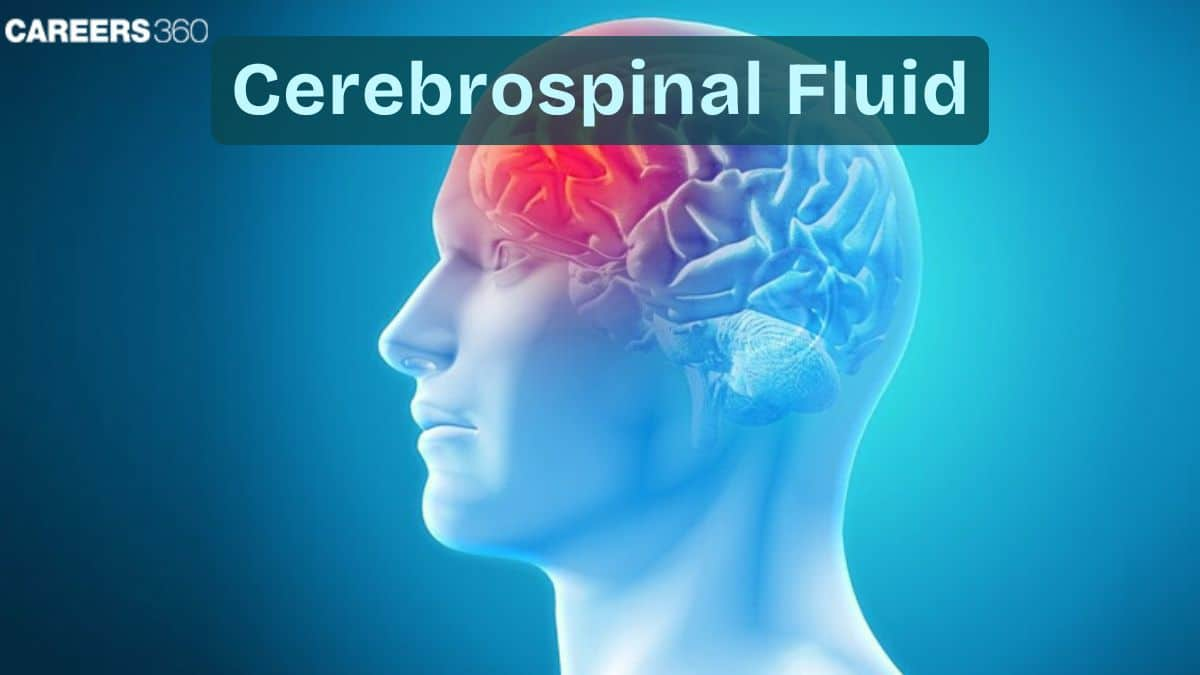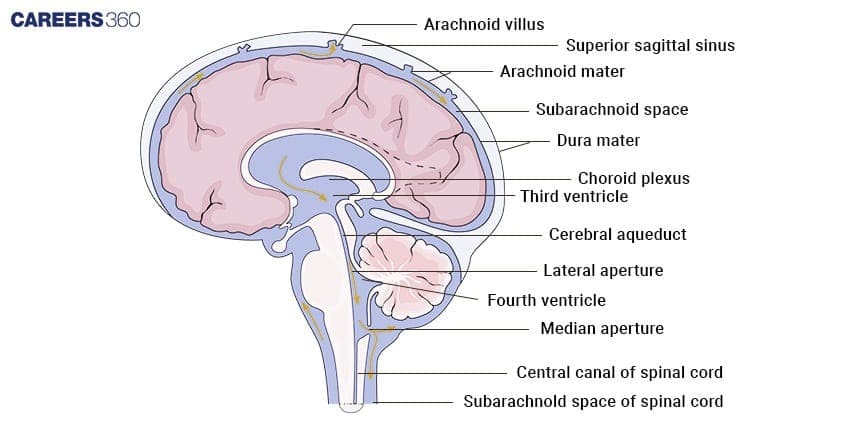cerebrospinal fluid: definition, meaning, function, diagram, circulation
Cerebrospinal fluid (CSF) is a clear, protective fluid that cushions the brain and spinal cord while maintaining chemical and metabolic stability. Produced mainly by the choroid plexus, it circulates through the ventricles, central canal, and subarachnoid space. This guide explains CSF anatomy, circulation pathway, functions, composition, absorption, NEET MCQs, diagrams, and clinical relevance.
This Story also Contains
- What Is Cerebrospinal Fluid (CSF)?
- Anatomy & Physiology Of CSF
- CSF Circulation Pathway (Step-by-Step)
- CSF Production
- Composition of CSF
- Functions of Cerebrospinal Fluid
- CSF Absorption Mechanism
- Cerebrospinal Fluid NEET MCQs (With Answers & Explanations)
- Recommended video on "Cerebrospinal Fluid"

What Is Cerebrospinal Fluid (CSF)?
The cerebrospinal fluid is a clear, colourless fluid, located within the ventricles of the brain and in the spinal canal. It provides important protection for the brain and spinal cord against mechanical shocks. The CSF also maintains homeostasis by nutrient transport, metabolic waste removal, and the regulation of the chemical environment in the brain.
Anatomy & Physiology Of CSF
The anatomy and physiology of cerebrospinal fluid is discussed-
Location of CSF
The location and circulation of CSF is:
Ventricles of the Brain
CSF is produced inside the ventricles of the brain.
The ventricles include two lateral, one-third, and one-fourth.
CSF moves from the lateral ventricle to the third ventricle through the interventricular foramen and further to the fourth ventricle via the cerebral aqueduct.
Central Canal of Spinal Cord
CSF, on leaving the fourth ventricle, flows into the central canal of the spinal cord.
It is present along the entire length of the spinal cord, cushioning and protecting the tissues of the spinal cord.
Subarachnoid Space
The CSF also flows in the subarachnoid space, which envelopes the brain and the spinal cord.
This is a space between the arachnoid mater and pia mater, two of the meninges covering the brain and spinal cord.
In this space, CSF functions as a shock absorber and maintains constant conditions in the central nervous system.
Since there is no apparent effect of gravity, it causes both upward and downward flow of CSF hence mixing well.
CSF Circulation Pathway (Step-by-Step)
Cerebrospinal fluid is produced within the ventricles of the brain by the choroid plexus. CSF circulation follows this pathway:
Lateral Ventricles: The CSF is produced first in the lateral ventricles.
Interventricular Foramina (Foramina of Monro): These openings allow the CSF from the lateral ventricle to enter the third ventricle.
Third Ventricle: The CSF flows further in the third ventricle.
Cerebral Aqueduct (Aqueduct of Sylvius): From the third ventricle, the CSF passes through this narrow canal into the fourth ventricle.
Fourth Ventricle: The CSF accumulates within the fourth ventricle.
Foramina of Luschka and Magendie: The CSF leaves the fourth ventricle through these apertures into the subarachnoid space that encapsulates the brain and spinal cord.
Subarachnoid Space: In this space, the CSF flows around the brain and spinal cord, providing cushion and homeostasis.
CSF Production
The ventricles of the brain are lined with a structure called the choroid plexus, which produces CSF.
The blood is filtered to produce CSF, which is secreted into the ventricles.
The composition and volume of CSF are regulated by the choroid plexus, and it contains the correct concentration of nutrients and ions.
It also clears waste products.

Composition of CSF
The composition of CSF includes:
Major Components
The main composition of CSF is water, almost 99%.
CSF contains numerous ions and molecules essential for the maintenance of the extracellular environment of the brain.
The most common ones are sodium, potassium, chloride, bicarbonate, glucose, and proteins.
Role of Composition in Brain Function
High water content is the reason behind the ability to act like a cushion and shock-absorbing material for the brain and the spinal cord.
In relation, the choroid plexus tightly controls the concentration of these ions and molecules to provide an optimal environment for neuronal activity.
Functions of Cerebrospinal Fluid
The cerebrospinal fluid performs the following primary functions that play a significant role in maintaining health and stability within the CNS.
Mechanical Protection (Shock Absorption)
CSF serves to cushion the brain and spinal cord.
It protects these delicate structures from mechanical shocks and impacts through the mechanism of absorbing and dissipating external forces, which may cause injuries, especially those involving trauma.
The CSF cushions optimally reduce the effective weight of the brain.
The actual weight of the brain is about 1400 grams, but, because of buoyancy provided by the CSF, its net weight drops down to about 50 grams.
This reduced weight avoids pressing the brain onto the base of the skull and the spinal cord thus saving it from damage.
Homeostasis
CSF is concerned with removing metabolic waste products from the brain.
In line with their mandate, neurons and other brain cells produce wastes in the course of performing their duties, which need to be flushed out of the system.
CSF facilitates the transportation of such waste products from the brain into the bloodstream for excretion.
CSF plays a very essential role in maintaining the intracranial pressure within a narrow optimal range.
Via its incessant circulation and subsequent reabsorption, CSF aids in the balancing of pressure inside the skull, ensuring that it stays stable despite alterations in the volume of the brain or blood flow.
Removal Of Metabolic Waste
CSF is concerned with removing metabolic waste products from the brain.
In line with their mandate, neurons and other brain cells produce wastes in the course of performing their duties, which need to be flushed out of the system.
CSF facilitates the transportation of such waste products from the brain into the bloodstream for excretion.
Nutritional Support
CSF serves as a medium for the delivery of essential nutrients like glucose, ions, and other molecules to the nervous tissue.
This delivery system thus presents substances to the brain cells, which will sustain energy production and metabolic processes.
CSF Absorption Mechanism
The processes involved in CSF circulation and absorption are:
Arachnoid Villi & Granulations
Small projections of the arachnoid membrane—one of the meninges surrounding the brain—into the dural venous sinuses are called arachnoid villi.
These villi then congregate to form arachnoid granulations.
The CSF is absorbed via the arachnoid villi and granules directly into the bloodstream.
These structures can be considered to provide one-way valves that permit the flow of CSF from the subarachnoid space into the dural venous sinuses but block backward flow.
The main site of absorption is the superior sagittal sinus, which is a big venous channel running along the top of the brain.
In the process, CSF is returned to the circulating venous system, whereby a constant volume and pressure are maintained within the CNS.
Clinical Importance
The proper circulation and resorption of CSF protect the brain and spinal cord and ensure metabolic waste removal and delivery of nutrients.
CSF flows from the ventricles through the subarachnoid space, draining into the bloodstream via arachnoid villi and granulations into the venous sinuses.
This constitutes an important function in maintaining equilibrium and activity of the CNS.
Cerebrospinal Fluid NEET MCQs (With Answers & Explanations)
Important questions asked in NEET from this topic are:
Anatomy and physiology of CSF
Functions of CSF
Practice Questions for NEET
Q1. Cerebrospinal fluid is secreted by
Choroid plexus
Foramina of Monro
Foramen of Magendie
Cauda equina
Correct answer: 1) Choroid plexus
Explanation:
Cerebrospinal fluid (CSF) is a colorless, transparent liquid produced by choroid plexuses, which are created from vascular tissue situated in the brain's ventrals. A CSF is produced by the choroid plexus made up of a capillary bed and ependymal cells that extract blood plasma and filter it. This fluid is moved among the subarachnoid space, spinal cord central canal, and ventricles.
Hence, the correct answer is option 1) Choroid plexus.
Q2. Cerebrospinal fluid fills the space between
The arachnoid and pia mater of the central nervous system (CNS)
The ventricles of the brain
The central canal of the spinal cord
All of the above
Correct answer: 4) All of the above
Explanation:
The cerebrospinal fluid (CSF) is a clear watery nutritional fluid containing sodium chloride, potassium, glucose, and various proteins. It fills the space between the arachnoid and pia mater of the central nervous system (CNS), the ventricles of the brain, and the central canal of the spinal cord. It is secreted by the choroid plexuses. In addition to providing a nutritional supply to the brain, the CSF also removes by-products of metabolism and also serves to provide a fluid cushion to protect the brain from injury.
Hence, the correct answer is option 4) All of the above.
Q3. Assertion:CSF Fluid movement is pulsatile, matching the pressure waves generated in blood vessels by the beating of the heart.
Reason: CSF moves in a single outward direction from the ventricles, but multi directionally in the subarachnoid space.
If both Assertion & Reason are true and the reason is the correct explanation of the assertion, then mark A
If both Assertion & Reason are true but the reason is not the correct explanation of the assertion, then mark B
If Assertion is true statement but Reason is false, then mark C
If both Assertion and Reason are false statements, then mark D
Correct answer: 1) If both Assertion & Reason are true and the reason is the correct explanation of the assertion, then mark A
Explanation:
Both Assertion & Reason are true and the reason is the correct explanation of the assertion. CSF moves in a single outward direction from the ventricles, but multi directionally in the subarachnoid space. Fluid movement is pulsatile, matching the pressure waves generated in blood vessels by the beating of the heart. But believes that there is no unidirectional CSF circulation, but cardiac cycle-dependent bi-directional systolic-diastolic to-and-from cranio-spinal CSF movements.
Hence, the correct answer is option 1) If both Assertion & Reason are true and the reason is the correct explanation of the assertion, then mark A
Also Read:
Recommended video on "Cerebrospinal Fluid"
Frequently Asked Questions (FAQs)
The cerebrospinal fluid is a limpid colorless transparent liquid that goes through the ventricles of the brain and in parts of the spinal canal. Its functions is protection against mechanical damage to the brain and spinal cord.
The CSF originates mainly in the choroid plexus, a fringed mesh of blood vessels of the meninges that projects into the ventricles of the brain.
Abnormalities in CSF have been related to hydrocephalus, and multiple sclerosis, an autoimmune disorder against the central nervous system.
In the medical test of the lumbar puncture, also referred to as a spinal tap, a small amount of extracted cerebrospinal fluid is sent for diagnostic study.
The normal CSF is clear and colourless. The following are the usual measurements given:
Pressure: 10-20 cm H2O
Protein: 15-45 mg/dL
Glucose: 50-80 mg/dL (~ 60-70% of the amount in the blood)
White Blood Cells: 0-5 cells/µL
Red Blood Cells: None or very few (0-10 cells/µL)
Chloride: 110–125 mEq/L. The values may differ slightly depending on the laboratory and characteristics of the patient; however, gross deviation from these ranges may mean some underlying pathology.